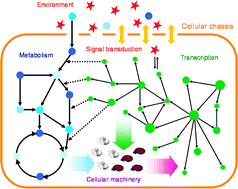Towards the automated engineering of a synthetic genome†
Abstract
The development of the technology to synthesize new

Maintenance work is planned for Wednesday 1st May 2024 from 9:00am to 11:00am (BST).
During this time, the performance of our website may be affected - searches may run slowly and some pages may be temporarily unavailable. If this happens, please try refreshing your web browser or try waiting two to three minutes before trying again.
We apologise for any inconvenience this might cause and thank you for your patience.
* Corresponding authors
a Instituto de Biología Molecular y Celular de Plantas, Consejo Superior de Investigaciones Científicas-UPV, 46022 València, Spain
b Instituto ITACA, Universidad Politécnica de Valencia, 46022 València, Spain
c
Synth-Bio Group, Epigenomics Project, Genopole-Université d’Évry Val d’Essonne-CNRS UPS 3201, 91034 Évry, France
E-mail:
Alfonso.Jaramillo@polytechnique.fr
Fax: +33 169474437
Tel: +33 169474444
d Laboratoire de Biochimie, École Polytechnique-CNRS UMR 7654, 91128 Palaiseau, France
The development of the technology to synthesize new

 Please wait while we load your content...
Something went wrong. Try again?
Please wait while we load your content...
Something went wrong. Try again?
J. Carrera, G. Rodrigo and A. Jaramillo, Mol. BioSyst., 2009, 5, 733 DOI: 10.1039/B904400K
To request permission to reproduce material from this article, please go to the Copyright Clearance Center request page.
If you are an author contributing to an RSC publication, you do not need to request permission provided correct acknowledgement is given.
If you are the author of this article, you do not need to request permission to reproduce figures and diagrams provided correct acknowledgement is given. If you want to reproduce the whole article in a third-party publication (excluding your thesis/dissertation for which permission is not required) please go to the Copyright Clearance Center request page.
Read more about how to correctly acknowledge RSC content.
 Fetching data from CrossRef.
Fetching data from CrossRef.
This may take some time to load.
Loading related content
